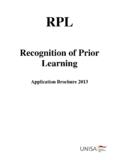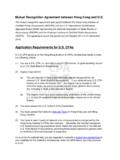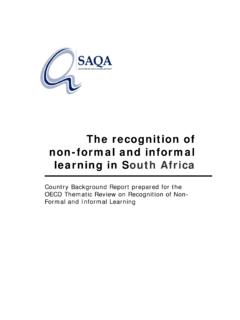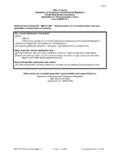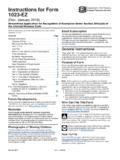Transcription of A closer look at the new revenue recognition …
1 Applying IFRSIFRS 15 revenue from Contracts with CustomersA closer look at the new revenue recognition standardJune 2014 June 2014 A closer look at the new revenue recognition standard 2 Overview The International Accounting Standards Board (IASB) and the US Financial Accounting Standards Board (FASB) (collectively, the Boards) have jointly issued a new revenue standard, IFRS 15 revenue from Contracts with Customers, that will supersede virtually all revenue recognition requirements in IFRS and US GAAP. Noting several concerns with existing requirements for revenue recognition under both US GAAP and IFRS, the Boards decided to develop a joint revenue standard that would: Remove inconsistencies and weaknesses in the current revenue recognition literature Provide a more robust framework for addressing revenue recognition issues Improve comparability of revenue recognition practices across industries, entities within those industries, jurisdictions and capital markets Reduce the complexity of applying revenue recognition requirements by reducing the volume of the relevant standards and interpretations Provide more useful information to users through new disclosure requirements1 IFRS 15 specifies the accounting treatment for all revenue arising from contracts with customers.
2 It applies to all entities that enter into contracts to provide goods or services to their customers, unless the contracts are in the scope of other IFRSs, such as IAS 17 Leases. The standard also provides a model for the measurement and recognition of gains and losses on the sale of certain non-financial assets, such as property or equipment. As a result, IFRS 15 will likely affect an entity s financial statements, business processes and internal control over financial reporting. While some entities will be able to implement the standard with limited effort, others may find implementation a significant undertaking. An early assessment will be the key to managing implementation. While the Boards actually issued two separate standards, we refer to them in this publication as a single standard.
3 The standards under IFRS and US GAAP are identical except for the following: The Boards use the term probable to describe the level of confidence needed when assessing collectability to identify contracts with customers, which has a lower threshold under IFRS than US GAAP (as discussed in Section ) The FASB requires more disclosures in interim financial statements than the IASB The IASB allows early adoption The IASB permits reversals of impairment losses and the FASB does not 1 IFRS 3 June 2014 A closer look at the new revenue recognition standard The FASB provides relief for non-public entities (as defined in the US GAAP version of the standard)
4 Relating to specific disclosure requirements, the effective date and transition The standard outlines the principles an entity must apply to measure and recognise revenue and the related cash flows. The core principle is that an entity will recognise revenue at an amount that reflects the consideration to which the entity expects to be entitled in exchange for transferring goods or services to a customer. The principles in IFRS 15 will be applied using the following five steps: 1. Identify the contract(s) with a customer 2. Identify the performance obligations in the contract 3. Determine the transaction price 4. Allocate the transaction price to the performance obligations in the contract 5.
5 Recognise revenue when (or as) the entity satisfies a performance obligation An entity will need to exercise judgement when considering the terms of the contract(s) and all of the facts and circumstances, including implied contract terms. An entity also will have to apply the requirements of the standard consistently to contracts with similar characteristics and in similar circumstances. In response to feedback received, the Boards included more examples in the final standard than they had in the November 2011 exposure draft. We include a list of these examples in Appendix B to this publication. IFRS 15 must be adopted using either a fully retrospective approach for all periods presented in the period of adoption (with some limited relief provided) or a modified retrospective approach.
6 For IFRS preparers, the standard is mandatorily effective for annual periods beginning on or after 1 January 2017. US GAAP preparers must adopt the standard for annual periods beginning after 15 December 2016. Early adoption is permitted for entities that report under IFRS, but not for public entities (as defined in the US GAAP version of the standard) that report under US GAAP. This publication highlights key aspects of IFRS 15. We also plan to issue industry-specific publications that will address, in further detail, significant changes to current industry practice. We encourage preparers and users of financial statements to read this publication and the industry supplements carefully and consider the potential effects of the standard.
7 The views we express in this publication are preliminary. We may identify additional issues as we analyse the standard and as entities begin to apply it and our views may evolve during that process. 4 June 2014 A closer look at the new revenue recognition standard Contents Overview .. 2 1. Effective date and transition .. 7 Effective date .. 7 Transition approach .. 7 Application considerations .. 13 2. Scope .. 16 Definition of a customer .. 16 Collaborative arrangements .. 17 Interaction with other standards .. 18 3. Identify the contract with the customer .. 20 Attributes of a contract .. 21 Combining contracts .. 25 Contract modifications .. 26 Arrangements that do not meet the definition of a contract under the standard.
8 33 4. Identify the performance obligations in the contract .. 36 Identifying the promised goods and services in the contract .. 36 Separate performance obligations .. 40 Goods and services that are not distinct .. 45 Principal vs agent considerations .. 46 Consignment arrangements .. 51 Customer options for additional goods or services .. 51 Sale of products with a right of return .. 53 5 Determine the transaction price .. 55 Variable consideration .. 56 Accounting for specific types of variable consideration .. 67 Significant financing component .. 69 Non-cash consideration .. 74 Consideration paid or payable to a customer .. 75 Non-refundable upfront fees.
9 79 6 Allocate the transaction price to the performance obligations .. 81 Estimating stand-alone selling prices .. 81 Applying the relative stand-alone selling price method .. 90 Allocating variable consideration .. 91 Allocating a discount .. 94 Changes in transaction price after contract inception .. 97 Allocation of transaction price to components outside the scope of IFRS 15 .. 97 5 June 2014 A closer look at the new revenue recognition standard 7 Satisfaction of performance obligations .. 99 Performance obligations satisfied over time .. 99 Control transferred at a point in time .. 111 Repurchase agreements .. 115 Bill-and-hold arrangements.
10 119 Customer acceptance .. 121 Licensing and rights to use .. 122 Recognising revenue when a right of return exists .. 122 Breakage and prepayments for future goods or services .. 123 Onerous contracts .. 124 8 Other measurement and recognition topics .. 125 Warranties .. 125 Onerous contracts .. 129 Contract costs .. 129 Licences of intellectual property .. 135 9 Presentation and disclosure .. 144 Presentation of contract assets, contract liabilities and revenue . 144 Disclosure objective and general requirements .. 145 Specific disclosure requirements .. 146 10 Implementation considerations .. 157 Not just an accounting change .. 157 Implementing accounting change.











